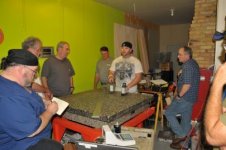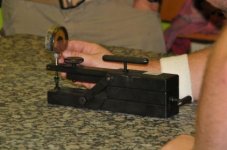Not to hijack your post, but I'm going through this right now.

I sort of suspected that after years in my shop, my inspection equipment is not up to snuff when I planed John Oder's straight edge last year. I came to the conclusion that after planing, despite several straight edges & a couple surface plates here, none were reliable enough to determine actual error. Strictly speaking, this did not affect my agreement with John, since he generously planned to accept whatever result off the planer was better than the SE as received. I had said that if it came off worse than (IIRC) .003" total tolerance, I'd rough scrape the error down a bit before shipping. As it turned out, I detemined that I could not actually measure error in a 5' SE with the (condition of) tools in my shop at the time beyond a guess, and in retrospect thankfully did not try to scrape it. John was gracious enough to take the SE as was.

Fast forward to this year, I recently planed a nused 54" bed to put under my 10K and went to scrape it. I went further along than I should have before stopping and addressing the tools. After some careful checking, it turns out my primary 4' SE had a twist in it, my secondary was indeterminate since there was nothing reliable to check against, and my 24 x 36" B & S plate is shaped like a mound, so no using it across the diagonals to check or scrape the SE's.
I only have 2 4-footers (and nothing longer) So have been gradually scraping them in yesterday by checking against each other, and then the ends on a fair 18 x 24" Starrett plate that was new to me from the factory, and on a section of the B & S plate that registers that both SE's are in fact concave when checked to each other and to the plate in that area. What is difficult to assign reliably, is which one is more concave at the moment, but they are trending well together. I do recognize that when I decide they are finished, without 3 full length SE's tpo compare, one will probably be ever so faintly concave, and the other convex. But it is interesting how closely that can be for both, to flat & I think I can determine which is which, applying them to the lathe bed as the 3rd reference.
I would advise strongly that you be absolutely certain your plate is flat in the area used to work your angles, or they will not be a true 90°. Further, if you have not done this before, tiny amounts of marking medium with throw the angle as you get down to final resolution. Try this: clean the plate and the work scrupulously. See how 2 squares hit. Now take a new magic marker and draw a line on the bottom at one end, of one of your squares. This will essentially create a shim. Now see how they hit. (be sure to clean any wet marker off the plate, or it will locally throw anything that passes over it later.)
Blue works the same way: let one end thin more than the other or ride thew work while checking over an area where the die is partial, and the indication will be off. By the time the angles are being final proven, there should be enough die on the plate to faintly register on the work, but not enough to feel with your hands as a drag. Of course this would be for an inspection angle; if the angles are going to be used on a mill, they don't have to be that final degree of match since use will quickly mar/wear them.
smt













